- A gravitational force of attraction exists between all objects with mass
- The magnitude of this force decreases with increased separation
- The force of gravity you experience due to the Earth (W=mg) is proportional to your mass
Consider the forces acting on a mass falling towards the Earth:

Gravitational field strength = g
Ignoring the effects of air resistance, the resultant force is the weight = mg.
According to Newton’s second law of motion, resultant force is equal to mass x acceleration, F = ma.
So, ma = mg
a = g (ms⁻²)
Uniform gravitational fields
- Constant gravitational field strength, g (Nkg⁻¹)
- Field lines (fields of force) are parallel, the same size, and equally spaced
- Equipotential lines (Jkg⁻¹) are perpendicular to the field lines
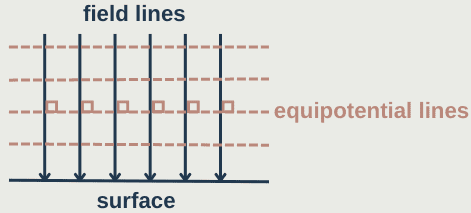
Radial fields
- Field lines act radially (towards the centre of mass)
- Equipotential lines are perpendicular to the field lines
- As you move further away from the centre of mass, field lines get further apart causing field strength to weaken

Newton's Universal Law of Gravitation
Between any two masses there is a gravitational force of attraction, the magnitude of which is directly proportional to the product of the masses and inversely proportional to the square of the separation of their centres of mass.
The force which mass A exerts on mass B is of the same magnitude but exactly opposite direction to the force mass B exerts on mass A (Newton’s third law, pair of forces).
Here we have two objects with masses M and m exerting a force, F, on each other. R is the distance between the centres of the objects.
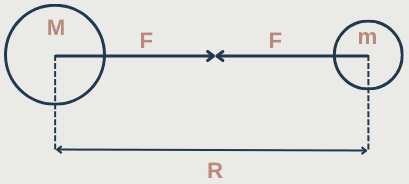
F ∝ Mm
F ∝ 1/R²
Combining these gives:
F ∝ Mm/R²
or F = GMm/R²
where G is the universal constant of gravitation (6.67 x 10⁻¹¹ Nm²kg⁻²)
Gravitational Force and Field Strength
Field strength is the force per unit mass, it is a vector quantity and its units are Nkg⁻¹.
W = mg
As the weight of an object is equal to the gravitational force, the equation can be rearranged to give:
g = W/m
g is the gravitational field strength (Nkg⁻¹)
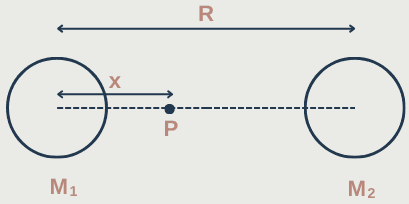
What is the gravitational field strength acting on the mass, m, at the point P?
Forces on m:

Resultant force = GM₂m/(R-x)² – GM₁m/x²
At P, g = resultant force / m
g = GM₂/(R-x)² – GM₁/x²
(m cancels out)
g = G(M₂/(R-x)² – M₁/x²)
(Factorising out G)
At what value of x does g = 0?
When g = 0:
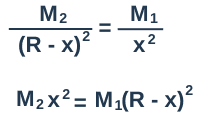
Rearrange to make x the subject:
x = R/(1+√(M₂/M₁))
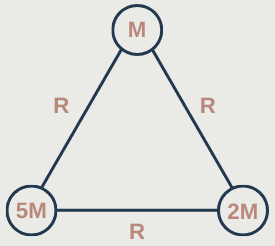
Find the magnitude and direction of the resultant gravitational force on M
F = GMm/r²
F₁ = 5GM²/R² and F₂ = 2GM²/R²

Resolve the forces:
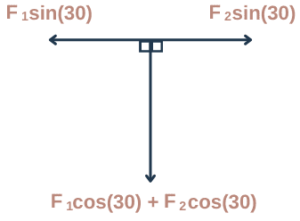
As sin(30) = 1/2 and cos(30) = √3/2:
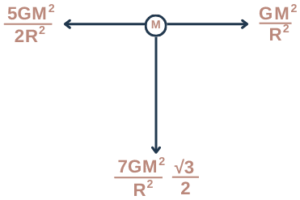
Now we can find the horizontal force by subtracting GM²/R² from 5GM²/2R² to give us 3GM²/2R². With the forces resolved into their horizontal and vertical components, we can use pythagoras to find the magnitude of the resultant force and its angle.

Using pythagoras, we find that the magnitude of the resultant force is √(39) and using the inverse tan function, we can find the angle theta.
tan⁻¹(√3/7) = 13.9° to the horizontal.

RE = Earth’s radius
ME = mass of Earth
(use values from data sheet)
For what height above the Earth's surface is 9.81 Nkg-1 to 3sf still valid?
1. Combining F = GMEm/RE² and g = F/m gives us:
g = GME/RE²
2. Sub in the values:
g = (6.67 x 10⁻¹¹ x 5.97 x 10²⁴)/(6.37 x 10⁶)²
g = 9.81 Nkg⁻¹ (to 3sf)
3. The smallest value that still rounds to 9.81 to 3sf is 9.805.
9.805 = (6.67 x 10⁻¹¹ x 5.97 x 10²⁴)/(6.37 x 10⁶ + H)²
4. Rearrange to make H the subject:
6.37 x 10⁶ + H = 6372741
H = 2741 m
Using the diagram and graph below, describe the effect of gravity on a rocket travelling from the Earth to the Moon and back.
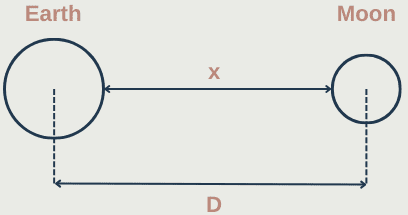
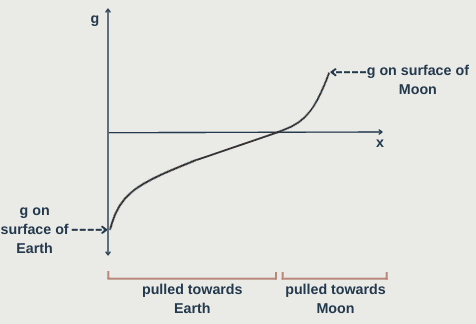
A rocket going from the surface of the Earth to the Moon has to overcome a greater gravitational force for a longer period of time before the Moon’s gravitational force pulls on it. On the way back, the rocket has to overcome a smaller gravitational force for a shorter distance until the pulling force of the Earth takes over. Gravitational field strength is a vector quantity – this is why the curve 1/D² goes under the x-axis.
Linking gravitational field strength on planet surface to mean planet density:
A planet has mass M, density ρ and radius R.
g = GM/R²
ρ = M/V
ρ = M/(4/3)πR³ = (mass / volume of sphere)
g = G/R² x (4/3)πR³ρ
g = (4/3)πGρR
Gravitational Potential
- Scalar quantity
- Jkg⁻¹ (energy per unit mass)
- Symbol = V
For a uniform field:

The work done in moving a mass m from potential V to potential V + ΔV is equal to the gain in potential energy, Ep = mΔV = mgΔh. This is independent of the route taken.
In a radial field:
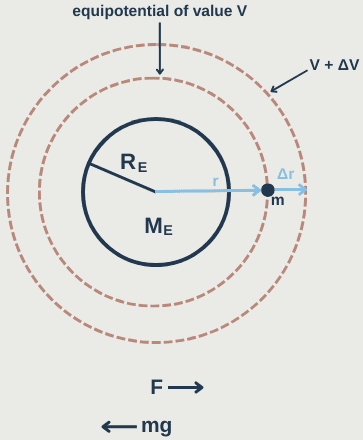
The work done in moving a mass m from r to r + Δr:
Work done = mΔV = FΔr
The force F to the left must balance the mg force to the right:
F = -mg
(mΔV/Δr) = -mg
-mgΔr = mΔV
or g = -ΔV/Δr
(m cancels out)
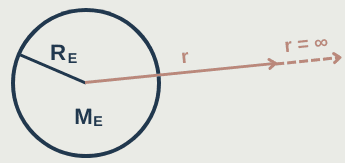
We know that a gravitational force of attraction acts between objects with mass. As the separation between these two masses increases, the gravitational force decreases.
At a separation of infinity, the gravitational force is negligible and the gravitational potential V approaches zero as r approaches infinity.
r = ∞, V = 0
If two masses are left alone, they’ll move closer due to natural attraction. By moving the masses closer together (reducing the separation) faster than their natural attraction, you are doing work on the system.
This added work increases the kinetic energy of the system.
When masses naturally move closer due to gravitational attraction, their gravitational potential energy decreases and is converted into kinetic energy. As we use infinity as a reference point, for the gravitational potential energy to decrease as the masses get closer, V would have to become more negative.
V = -GM/R
Gravitational Potential
The gravitational potential at any point in a gravitational field is defined as the work done by a point mass on the field in moving it from infinity to that point.
Why are the values of equipotentials negative?
As you get closer to a mass, the potential becomes more and more negative which is why the values of equipotentials are negative – the potential must be zero when the distance is infinite.
A negative potential value signifies that work would need to be done against the gravitational field to move the object from its current position to a position infinitely far away.
Gravitational Potential Difference
- Denoted as ΔV
- ΔV = V₂ – V₁
- Jkg⁻¹
Gravitational potential difference is the work done per unit mass to move an object from one point to another within the field without changing its kinetic energy (the difference in gravitational potential).
Equipotential Surfaces
An equipotential surface is an imaginary surface in a field where the potential is the same at every point.
- All points on an equipotential surface have the same gravitational potential
- No work is done when moving an object along an equipotential surface, because there is no change in gravitational potential energy
- Equipotential surfaces are always perpendicular to field lines
Escape Velocity
Escape velocity refers to the instantaneous velocity at launch. There is no continuous propulsion and we are ignoring other forces such as air resistance.
This is the minimum speed an object must travel to escape the gravitational field at the surface of a mass (without further propulsion).
It is the velocity at which the object’s gravitational potential energy is equal to its kinetic energy (or when they sum to equal zero).

As mass m moves from M, gravitational potential energy increases and kinetic energy decreases.
So 1/2 mvesc ² = gain in Ep
1/2 mvesc ² = 0 – – GM/r (0 is the gravitational potential at infinity)
1/2 mvesc ² = (GM/r) x m
We are multiplying by m because the units of gravitational potential are Jkg⁻¹ but the units of kinetic energy are just joules, by multiplying by m, we are cancelling out the kg so both values are in joules.
1/2 mvesc ² = GMm/r
Rearrange to make vesc the subject:
vesc = √(2GM/r)
Find the escape velocity from the surface of the Earth:
G = 6.67 x 10⁻¹¹
M = 5.97 x 10²⁴
r = 6.37 x 10⁶
vesc = √(2GM/r)
vesc = √(2 x 6.67 x 10⁻¹¹ x 5.97 x 10²⁴ / 6.37 x 10⁶)
vesc = 11200 ms⁻¹ (3sf)
As we know that mass = density x volume:
m = ρ x 4/3 π r³
Escape velocity can also be given as:
vesc = √(8Gπr³ρ/3r)
vesc = r√(8Gπρ/3)
Graphical representations of Gravitational Potential
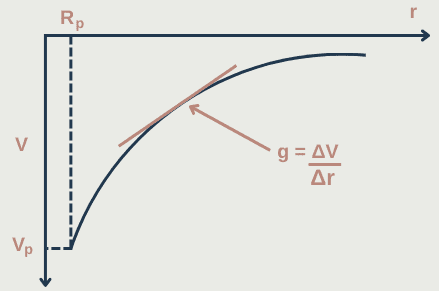
The diagram above shows a graphical representation of the equation V = -GM/r where Rₚ is the surface of the planet and Vₚ is the gravitational potential on the surface of the planet (G and M are constants).
The values for V are all negative and r is the distance from the centre of the planet. The gradient at any particular point can be found by drawing a tangent to the curve. Gradient = gravitational field strength at that radius.
As r increases, the graph follows a -1/r relation.
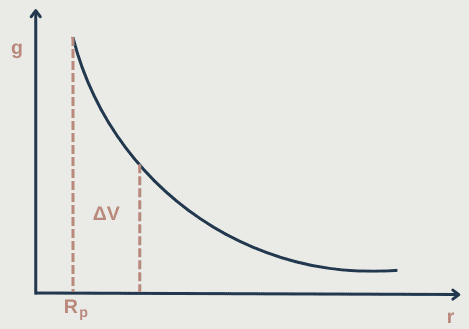
The diagram above is a graphical representation of the equation g = GM/r². The area under the graph is the change in gravitational potential.
As r increases, the graph follows a 1/r² relationship (inverse square law). This means that if r doubles, g decreases by a factor of 4.
Orbits
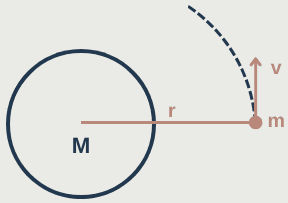
The gravitational force of attraction of M on m keeps m in circular orbit about M with linear speed v, so provides the centripetal force. Using Newton’s Law of Gravitation and his second law of motion, we can derive a relationship between orbital period (T) and radius (r) or a circular orbit.

Deriving and manipulating equations
At radius r, v = √(GM/r)
Or by substituting in g = GM/r2, v = √(gr)
Using this, we can say kinetic energy, Eₖ = 1/2mv² = 1/2mgr
We can also use the equation v = s/t in the form: v = 2πr/T
2πr is the circumference of orbit (displacement) and T is the period of orbit (the time taken for one complete orbit).
Substituting v = 2πr/T into GMm/r² = mv²/r:
GMm/r² = m/r x (2πr/T)²
Making T the subject:
T² = 4π²r³/GM
T = 2πr3/2/√(GM)

The equation shows that T² is proportional to r³. This relationship is often expressed as Kepler’s third law.
We can use logarithmic plots to show relationships between T and r:
Looking at the equation where T is the subject, we can let the power of r (3/2) be equal to the variable n. So, T ∝ rⁿ.
T = krⁿ
We can take logs of both sides to form a linear equation:
log₁₀(T) = log₁₀(k) + nlog₁₀(r)
y = c + m x
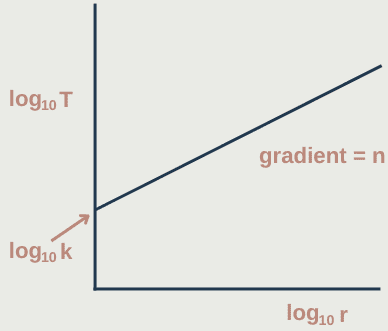
We can plot the same graph for the equation: T² = 4π²r³/GM

Satellite Orbits

Any satellite, if unpowered, must orbit the Earth above a great circle because the force of attraction is towards the centre of Earth.
A great circle splits the Earth into two hemispheres (it is the largest possible circle that can be drawn on the surface of a sphere).
Geostationary Satellites
A geostationary satellite must always be above the same point on the Earth’s surface. The only way it can be geostationary is if it’s above the equator.
The orbital period of the satellite must be 24 hours so that it stays above the same point on the equator. 24 hours is the time it takes for the Earth to rotate around its axis once.
Why does a geostationary satellite appear stationary when observed from Earth?
Because a geostationary satellite orbits the Earth at the same rate that the Earth rotates (its orbital period is equal to the Earth’s rotational period), it appears to be stationary when observed from the Earth’s surface.
It maintains a constant position relative to a specific point on the Earth’s surface.
Uses of geostationary satellites:
- Communication
- Broadcasting
- Weather and environmental monitoring
- Surveillance
Because they remain in a fixed position relative to a point on Earth, antennae and dishes can be permanently aligned with satellites without the need for tracking systems.
Their fixed position also allows for consistent and reliable signal reception and being equipped with cameras and sensors can provide real-time data on weather patterns and environmental changes.
At what height above the Earth's surface must geostationary satellites orbit?
The gravitational force of attraction provides the centripetal force:

GMm/(R+h)² = mv²/(R+h)
m can cancel out:
GM/(R+h)² = v²/(R+h)
Using the equations: ω = v/r and ω = 2πf = 2π/T, we get that v = 2πr/T
In this case, r = R+h so we can substitute this in.
GM/(R+h)² = (2π/T)² x (R+h)
= 4π²(R+h)/T²
(R+h)³ = GMT²/4π²
h = ³√(GMT²/4π²) – R
T needs to be in seconds so 24 x 3600 = 86400 s
h = ³√(6.67 x 10⁻¹¹ x 5.97 x 10²⁴ x (86400)² / 4π²) – (6.37 x 10⁶)
h = 35856910.18 m
h = 3.59 x 10⁷ m
This is the height above the Earth which geostationary satellites must orbit.
If a safe separation of geostationary satellites is 100m, how many could you fit in orbit?
Circumference of geostationary orbit = 2πr = 2π(R+h)
2π(6.37 x 10⁶ + 3.59 x 10⁷) = 265590242.9
265590242.9 / 100 = 2655902.429 ≈ 2.7 million satellites
A synchronous orbit is when the orbital period of the satellite is equal to the rotational period of the object being orbited.
Low Polar Orbit Satellites

Low polar satellites follow a path nearly perpendicular to the equator (travels from pole to pole), this allows the satellite to cover the entire surface of the Earth as the planet rotates on its axis beneath it.
As these satellites orbit closer to Earth, at a lower altitude, they are travelling faster due to their shorter orbital periods.
Uses:
- Observation
- Continuous environmental monitoring
- Weather forecasting
- Military purposes
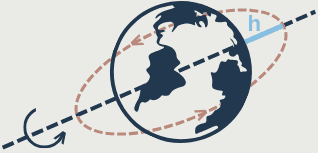
If n is the number of orbits the satellite completes in the time of one complete rotation of the Earth about its axis. What is h?
GMm/(R+h)² = mv²/(R+h)
m cancels out:
GM/(R+h)² = v²/(R+h)
v = 2π(R+h)/(T/n)
Where T is 24 hours and n is the number of complete orbits of the satellite.
Rearrange to make h the subject:
h = ³√(GMT²/4π²n²) – R
We have values for all the variables except n. The maximum value of n would be when h > 0 so, we can set h equal to zero and rearrange to make n the subject:
R = ³√(GMT²/4π²n²)
R³ = GMT²/4π²n²
n² = GMT²/4π²R³
n = √(GMT²/4π²R³)
n = T/2π x √(GM/R³)
Substitute in the values:
n = (24 x 3600)/2π) x √(6.67 x 10⁻¹¹ x 5.97 x 10²⁴ / (6.37 x 10⁶)³)
n ≈ 17
Therefore, n ≤ 17
Finally, we can substitute in n = 17 to find h:
h = ³√(GMT²/4π²n²) – R
h = ³√(6.67 x 10⁻¹¹ x 5.97 x 10²⁴ x 86400²/(4π²x 17²)) – (6.37 x 10⁶)
h = 16898.63332 m
h = 16900 m (3sf)
What is the best place to launch a satellite from?
The best place to launch a satellite is from the Earth’s equator as the Earth’s rotational speed is greatest at the equator. This means less additional work needs to be done on the satellite to get it into orbit so less fuel is required.
Elliptical Orbits
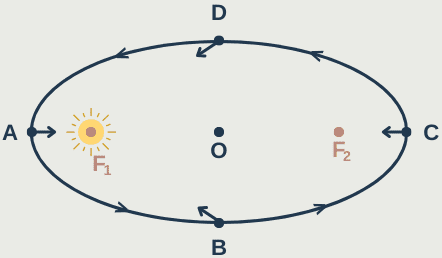
The diagram above shows a comet orbiting the Sun in an elliptical orbit.
F₁ and F₂ are the two focal points of the ellipse. Point A is the perihelion – the point at which the orbiting object is closest to the Sun (the object being orbited). Point C is the aphelion, this is where the orbiting object is furthest from the Sun.
The equation T² = 4π²r³/GM is still valid for elliptical orbits however, the radius should be taken as the semi-major axis (the length of AO or OC).
Total energy of orbiting satellite = Kinetic energy + Potential Energy
Explain the energy changes at each point as the comet orbits the Sun:
At point A, the comet is moving fastest as it is closest to the Sun, this means it has low gravitational potential energy and, therefore high kinetic energy.
At point B it is slowing down as it is moving further from the Sun the gravitational potential energy is increasing so the kinetic energy is decreasing – there is a component of the Sun’s gravitational force pulling on the comet.
At C, the comet is moving slowly with its lowest kinetic energy and highest gravitational potential energy.
At D the comet begins to speed up again as it gets closer to the Sun and its gravitational potential energy decreases.
